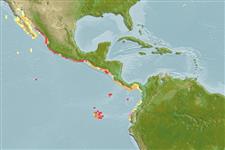Environment: milieu / climate zone / depth range / distribution range
Ecologia
marinhas associadas(os) a recifes; intervalo de profundidade 1 - 40 m (Ref. 55763). Tropical; 33°N - 2°S, 120°W - 70°W
Eastern Pacific: Gulf of California to Ecuador, including the Galapagos Islands (Ref. 9310); and Peru (first record).
Tamanho / Peso / Idade
Maturity: Lm ? range ? - ? cm
Max length : 53.0 cm TL macho/indeterminado; (Ref. 55763); common length : 25.0 cm TL macho/indeterminado; (Ref. 55763)
Descrição breve
Chaves de identificação | Morfologia | Morfometria
Body oval, somewhat elongate, and compressed (depth contained less than 2.0 times in standard length); head and mouth small; teeth highly characteristic, forming a single anterior row in each jaw, incisiform and somewhat lanceolate in shape, resembling the head of a golf club, their roots compressed and horizontally set, forming a striated plate inside the mouth; vomer toothed; dorsal fin with 13 soft rays; lateral line scales 59 to 61; first anal ray longer than subsequent rays; body entirely dark gray, with dark stripes on flanks; sometimes with white spots (Ref. 55763).
Sometimes seen in schools of K. analogus, also known to school and graze with Prionurus laticlavius. Stays close to shore in shallow waters. Feeds mainly on attached algae, occasionally ingests plankton and benthic invertebrates (Ref. 28023).
Life cycle and mating behavior
Maturidade | Reprodução | Desova | Ovos | Fecundidade | Larvas
Knudsen, S.W. and K.D. Clements, 2013. Revision of the fish family Kyphosidae (Teleostei: Perciformes). Zootaxa 3751(1):001-101. (Ref. 95491)
Categoria na Lista Vermelha da IUCN (Ref. 130435: Version 2024-1)
Ameaça para o homem
Harmless
Utilização humana
Pescarias: pouco comercial; peixe desportivo: sim
Ferramentas
Relatórios especiais
Descarregue XML
Fontes da internet
Estimates based on models
Preferred temperature (Ref.
123201): 18.6 - 28.4, mean 21.6 °C (based on 8 cells).
Phylogenetic diversity index (Ref.
82804): PD
50 = 0.5000 [Uniqueness, from 0.5 = low to 2.0 = high].
Bayesian length-weight: a=0.01778 (0.00765 - 0.04135), b=3.01 (2.81 - 3.21), in cm total length, based on LWR estimates for this (Sub)family-body shape (Ref.
93245).
Nível Trófico (Ref.
69278): 2.9 ±0.32 se; based on food items.
Resiliência (Ref.
120179): Médio, tempo mínimo de duplicação da população 1,4 - 4,4 anos (Preliminary K or Fecundity.).
Fishing Vulnerability (Ref.
59153): Moderate vulnerability (41 of 100).
Nutrients (Ref.
124155): Calcium = 38.5 [20.5, 64.7] mg/100g; Iron = 0.522 [0.325, 0.810] mg/100g; Protein = 18.5 [17.3, 19.6] %; Omega3 = 0.0913 [, ] g/100g; Selenium = 36.2 [21.1, 64.8] μg/100g; VitaminA = 43.6 [12.1, 144.5] μg/100g; Zinc = 1.09 [0.77, 1.52] mg/100g (wet weight);
